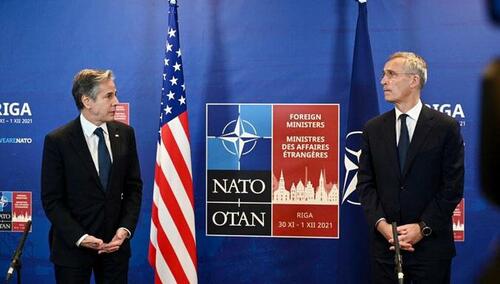Authored by Tom Luongo via Gold, Goats, ‘n Guns blog,
Sometimes the internet being eternal works to our advantage. Recently, there’s been a dustup in European politics over a three-year old video of now Italian Prime Minister Giorgia Meloni stepping on the third rail of European politics.

In that video she openly explained that colonialism in Europe isn’t over and she tied it to African immigration into Europe, which Italy has born the brunt of thanks to the EU’s rules which force countries to accept anyone that shows up on their shores.
The mechanism for France’s dirty colonial secret is they still control fourteen West African nations through a French colonial currency (CFA Franc) issued by France.
Now, since Meloni’s rant, the CFA Franc has been slightly revised but the real source of its power over West Africa was not, more on this later.
What’s important is that this video has all of a sudden resurfaced at a time when Italy and France are involved in a major row over France’s (and Davos’) latest attempt to paint Meloni as some heartless Fascist for denying a French NGO boatload of migrants from North Africa into Italy.
The boat eventually wound up having to go to France as Meloni stuck to her guns. Remember, folks it was then Interior Minister Matteo Salvini who first tried to defy Davos on this and his reward was to be sued in Sicilian court over ‘human rights abuses.’ This began Salvini’s fall from political power in Rome as he didn’t have enough support from his then coalition partner, Five Star Movement (M5S).
Eventually, Salvini was forced out of power, M5S cut a deal with the Rome Mafia to betray its supporters and the rise of Meloni and the Brothers of Italy (FdI) was inevitable.
The lame attempt by France to attack Meloni on immigration was met with a much different result this time as she enjoys a far stronger political position than Salvini did in 2017-18. So, the boat went to France and all the French could do was fulminate about it.
Enemy at the NGO Gates
In fact, the French Foreign Minister Gérald Darmanin went so far as to call Italy France’s enemy over this issue. This level of histrionics over less than 250 migrants is both so predictably French and overblown it borders on the comical.
So much for European solidarity, I guess.
But it’s all part of the silly Davos PR campaign against Meloni. Nothing changes with these people. They have a pathological need to win every single little battle, because as psychopaths they know any sign of weakness is an invitation to the gallows as people see them for what they are.
As always, the timing on this video of Meloni coming out is interesting. It’s a clear counterattack on France’s theatrics.
My question, as always, is who did this? Obviously Meloni’s people are part of this but does it imply she has some other support?
Stick with me, because I have a theory on this.
Ultimately, this dustup fully highlights the mendacity and, frankly, evil of the former colonial powers of Europe.
The CFA Franc was something that you ‘just didn’t talk about’ as France continued to extract wealth from West Africa through monetary expropriation.
The very idea that the vestiges of colonialism are on the wane in Europe is not only fundamentally false it is intrinsically woven into the fabric of the EU itself in every way. The CFA Franc should be an anachronism, but France holds onto for its benefit, subsidizing its ridiculous government and failing social institutions.
Among first world nations France has the highest effective tax rate for upper income earners. And yet, they still can’t keep things running effectively and have to extract wealth from north Africa.
How brutally inefficient and sickly is a French economy that derives nearly 50% of its electricity from a mostly-homegrown nuclear industry and has levels of taxation that make even a nineteenth-century slaveowner blush that it still needs to operate a colonial wealth extraction system in West Africa in the 21st century?
But it’s also a microcosm of the euro itself and even the corruption of the US dollar through national control over interest rates thanks to a monolithic central bank.
Like many of you, I had no idea the CFA Franc even existed and I’m still wrapping my head around the idea that in 2022 fourteen countries do not have monetary sovereignty, serfs to a feudal lord on a separate continent.
Again, just when I thought I’d plumbed the depths of Eurotrash globalist depravity, they make me look naïve.
But what’s been very clear is that the CFA Franc has been a no-go in international and inter-European political discussions for decades…. and someone close to Meloni just made it a global issue.
So much so, that no less than Le Monde had to put out a fire suppressor article. It’s a laughably poor piece of apologia. It’s a typical piece of ‘word parsing’ that picks out specific little exaggerations to discredit Meloni as stupid and uninformed while avoiding the basic problems of France running a wealth vacuum in 14 of the poorest countries in Africa.
Le Monde quickly switches to the ‘migrant’ issue to ‘debunk’ Meloni’s claims about African immigration as a result of the CFA Franc. Sure the country of origin of most migrants are from countries on the shore of the Mediterranean, but where did they come from in the first place?
It’s like saying Hondurans who cross into the US from Mexico aren’t Hondurans and that policy in Honduras didn’t contribute to the migration. But, this is really a side issue. Meloni is fundamentally right that the CFA Franc keeps these countries poor through currency arbitrage and contributes directly to North Africa’s instability and lack of economic progress.
To think that doesn’t have spillover effects into Algeria, Morocco or anywhere else along the southern Mediterranean is simply laughable.
It’s the Currency, Stupid!!
The key to understanding the evil of the CFA Franc is no different than understanding the evil of the euro or the Fed Funds Rate. It’s mercantilism through currency arbitrage.
The CFA Franc is not just pegged to the euro (formerly the French Franc) it is also tied to the ECB’s monetary policy debt rate. This is the part no one, especially the writer at Le Monde, wants to touch.
So, as Le Monde states there are the two central banks in Africa that issue the two different CFA Francs. What they fail to state is that both currencies are still pegged to the euro, making local monetary policy a joke. France and the ECB still control their economies.
The ECB’s monetary policy is set by Germany for Germany’s benefit. Having (up until now) the strongest economy in the EU, Germany gets an effective benefit from the euro trading at a single exchange rate.
If the euro were to collapse and the Deutschmark returned, it would rise dramatically versus the previous euro exchange rate. For Italy, the return of the lira would see it fall.
This is simply the value add/deficit of the labor in the aggregate of the country, represented by the exchange rate through the discounting mechanism.
This is why the euro and the EU are nothing more than colonialist systems designed to do exactly what they have done, impoverish the European periphery, which includes Italy, and concentrate capital in the center, in Brussels’ political power.
As much as I’ve used the Hunger Games to describe the US, it is even more apropos for the EU.
California and New York have used the singular Fed Funds Rate in the same way Germany has used the euro to dominate US electoral politics, ensuring that for decades their populations stayed high, the capital flowed to them, trapping people there and grinding them out between the twin millstones of inflation and taxation, just like Lenin described.
So, now applying that same model to France and it’s former colonies, does anyone believe that the labor efficiency of the Ivory Coast is the same as Germany? or even France?
Of course not. But that’s the situation for these countries. France is running the same mercantilist scam of any colonial power by keeping the home country’s currency weaker than it should be in exchange for real goods from abroad.
But we see this effect in the reverse from the colony’s perspective. By setting a peg for the CFA Franc, it is always stronger than it should be if allowed to float. Even if initially set weaker than it should be to attract capital, eventually the exchange rate will become an albatross around the colony’s neck, strangling economic growth while all the wealth is extracted back to the homeland, thanks to the ECB’s monetary policy.
While the CFA Franc was reformed slightly under Macron, the essential link between France’s banking system and these colonies remains key, using the ECB’s ruinous monetary policy to take the profit and leave misery behind.
Now, the good news is that mercantilism only works for so long before the currency mismatches become so great that the whole scheme has to collapse. It is, after all just another Ponzi Scheme.
In the case of France and Germany running their wealth extraction system across not just the 17 other countries of the euro-zone but 14 African countries as well, we’re reaching that breaking point.
Pres. Macron Tear Down This Peg!
Italy needs to be let loose from the euro. The populists and everyone not on Herr Schwab’s payroll understand this. Davos will blow up the world before letting that happen.
Meloni knows this. And she also knows that France has real designs on annexing parts of northern Italy and will fight very dirty to win here.
Macron tried to marginalize her on immigration, tugging on heart strings about denying migrants. She stood her ground, forced France to take the boats and when France tried to publicly shame her, she trotted out the CFA Franc and put that issue right to bed.
But here’s the fun part. She just put out her budget proposal for the EU’s consideration. It’s a very crafty proposal, skirting the edges of the rules set out by the EU, violating the spirit of the rules while not actually violating many of them. See this article from Reuters on rescinding the limits of cash use.
Martin Armstrong has a quick overview of the budget where he pulls out some of the salient points (from his perspective). His takeaway is that Meloni is putting real limits on Italy’s welfare state.
So, this is how she can play the game of not radically increasing spending. She’ll increase spending to subsidize rising energy costs clearly imposed on Italy by Germany and Brussels through ruinous sanctions on Russian energy as a stop gap measure. Sound familiar? Because this is what cost Liz Truss her job in the UK.
But she is also reforming the entitlement system for the long term which will keep the overall budget deficit which will call Brussels’ bluff on whether they will maintain support of Italy’s bond market.
We know this is a bluff otherwise ECB President Christine Lagarde wouldn’t have created the Transmission Protection Instrument to maintain internal credit spreads at the July meeting.
She knew this day was coming the minute Mario Draghi walked away from his post as Prime Minister. The TPI was announced the next day.
It looks like, at first glance, that Meloni’s found a way to circumvent being forced to implement “German Austerity” — raising taxes and cutting spending to protect bondholders — by cutting long-term entitlement spending while at the same time cutting taxes where they are needed most.
If there is a budget proposal that could mollify credit markets over Italy’s fiscal situation it would look something like this. It puts the EU on their back foot in budget talks. Because this plan could actually work.
Part of the budget plans includes slashing taxes for the self-employed by extending the 15% single tax rate from an annual income of €65,000 to €85,000, slashing VAT on certain essential goods by half, and conditionally reducing the retirement age to 62, provided that individuals have paid in at least 41 years of contributions.
What’s funny about this is that this budget, which explicitly breaks the EU’s cap of a 3% of GDP budget deficit, pushing it to 4.5% thanks to energy subsidies to families, is being hailed by the European press as “More EU Friendly than expected.”
What were they expecting, for Meloni to introduce miniBOTs and a new domestic currency like Salvini talked about in 2018?
No, this is clearly messaging that states Brussels isn’t in the position to fight her because she holds all the cards in the negotiations. Remember, $640+ billion in TARGET2 liabilities are the Bundesbank’s problem, not Italy’s.
Having exposed France to the world over the CFA Franc and understanding exactly how vulnerable the ECB and the EU Commission actually are in the Eurodollar markets, Meloni has pushed Italy into a good position to begin reversing the colonial extraction system of the EU itself.
A quick look at the polls in Italy has her riding a big lead at 30% support and moving higher. If she gets this budget past the EU Commission, that number will instantly jump to 40% or higher. The worry that Salvini and Berlusconi will betray her then drop precipitously.
The Ring Heads South
Remember, lurking in the background of all of this is Wall St., the Fed and patriots in the US military.
This is who I think is helping Meloni stand firm here. The Fed’s aggressive policy stance has the Eurodollar markets teetering and Lagarde is no longer talking about QEternity but QT and higher rates, albeit very grudgingly.
If the price cap on Russian oil fails and Ursula Von der Leyen cannot ride herd on a 9th sanctions package, then Italy will quickly move into the driver’s seat on energy imports into Europe.
Wall St. understands this. And with a grateful Meloni in Rome realigning EU policy or forcing a breakup it also paves the way for a new cycle of energy investment now beyond desperately needed.
Who wants in on that action? Well, pretty much everyone, especially Wall St.
Meloni just told France’s African colonies to stand up and follow Burkina Faso’s lead. With countries like Algeria, Egypt and Morocco all looking to join the BRICS alliance, the end of France’s colonial control over North Africa could end very quickly and Italy then has massive leverage on the EU to turn back on the sanctioned energy supplies.
This is a fight for all the EU marbles folks, and Meloni, I believe knows this. So, she’ll play the dutiful game of supporting Ukraine publicly. But, there’s almost nothing Italy can do practically to do that. It’s an empty promise. They have no money, no domestic military to speak of… what is that promise actually worth?
No, France and Germany, the mercantilist powerhouses, are the ones that have to foot this Ukraine bill. Meloni and Italy are happy to support them bankrupting themselves while she lays the groundwork for increasing Italy’s leverage over them.
The Fed is doing its job by forcing the euro down, bond yields up and taking options away from Christine Lagarde.
You beat colonialists by taking away their money printing machine. It’s that simple.
* * *
Join my Patreon if you don’t want to be colonized













